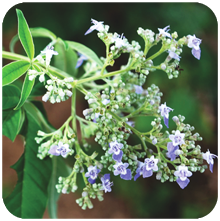
Vitex negundo is an erect shrub or small tree that grows 2-8 m in height. Bark is reddish-brown. Its leaves are digitate, with five (sometimes three) leaflets are lanceolate. The edges of the leaves are toothed or serrated. The flowers are numerous and sustained panicles up to 10-20 cm in length. Each flower is approximately 6-7 cm in length, white to blue in color. The petals are of different lengths, the lower middle lobe being the longest. Both corolla and calyx are covered in dense hairs. The fruit is a succulent drupe, 4 mm in diameter, rounded- egg-shaped and becomes black or purple in color at maturity.
Chemical composition – The leaves contain an alkaloid – nishindine, flavonoids, such as flavones, luteolin-7-glucoside, casticine, iridoid glycosides, essential oils and other components such as vitamin C, carotene, benzoic acid, nonital gluco-, β-sitosterol and C-glycosides.
Properties – Astringent, stomachic, antiseptic, thermogenic, depurative, rejuvenative, anti-gonorrhea, anti-inflammatory, anti-rheumatic, diuretic, expectorant, calming, sedative, relaxes bronchial smooth muscle, vermifuge and anthelmintic.
Recommendation – Angina, anxiety, arthritis, asthma, bronchitis, catarrh, cholera, colds, constipation, convulsions, cough, deafness, dermatitis, diarrhea, dropsy, dysentery, dyspepsia, eczema, enterosis, fever, flu, stomach problems, gastrosis, gonorrhea, hemorrhoids, hepatosis hernia, hiccups, inflammation, insomnia, jaundice, leucorrhea, lumbago, nervousness, parasites, rheumatism, sprain, urinary tract infections, dizziness, water retention, worms.
This plant is incorporated in natural remedy ARTRISALM.




